In a Pickle?
Sports medicine physicians say players should embrace the fun, yet know how to stay safe playing pickleball
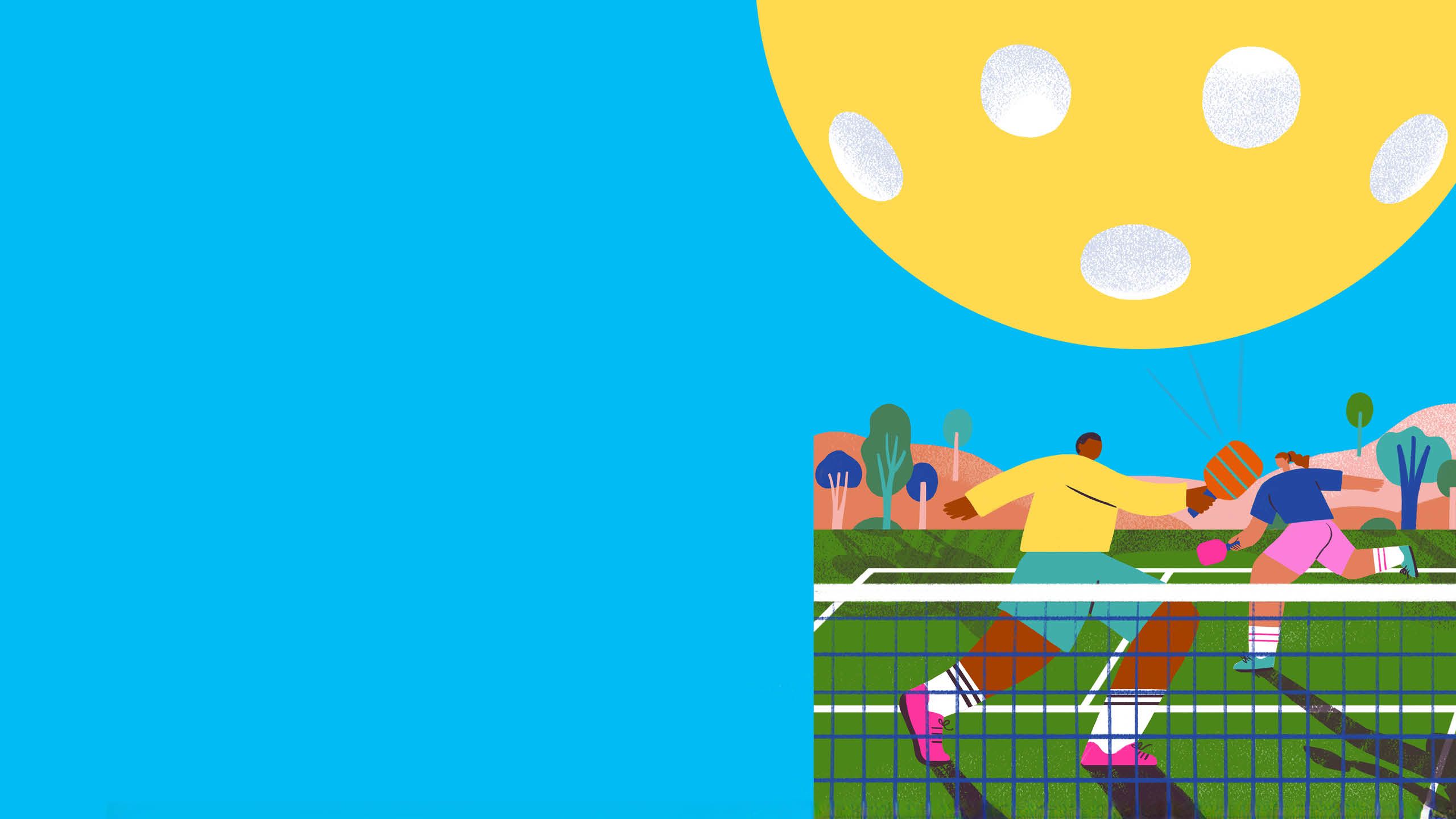
Pickleball is the fastest-growing sport in the country, with more than 36.5 million players, or “picklers,” according to the Association of Pickleball Players Pickleball Participation Report (try saying that three times fast).
Hundreds of newbies each month are picking up oversized ping-pong racquets, throwing on shorts and t-shirts, and facing off on pickleball courts sprouting forth like spring crocuses—whether at neighborhood swim and tennis clubs, dedicated pickleball facilities, or public parks.

A pickleball court is smaller than a tennis court—and, indeed, pickleball lines are sometimes painted on a court in addition to tennis lines for double duty. Some players even create their own courts with chalk or painter’s tape. The net is slightly lower, and a no-volley zone extends back from each side of the net called “the kitchen.” You serve underhand, and don’t get a second attempt if your serve goes out.
Played with perforated plastic balls (think wiffleballs) and wooden or composite paddles, pickleball is easy to learn, fast-paced, social, and good for your overall health. Studies have found picklers average a heart rate of 109 beats per minute and burn an average of 354 calories per hour: a moderately intense workout similar to yoga or water aerobics. Players can see improvements in cholesterol levels, blood pressure, and oxygen uptake if they play regularly.
A Dog Named Pickles

Sometimes described as an amalgam of tennis, ping-pong, and badminton, pickleball was invented by a trio of dads on Bainbridge Island in 1965, after a golf outing. They were looking for a game their whole family could play together, according to USA Pickleball, so Washington State Representative Joel Pritchard, business executive Bill Bell, and entrepreneur Barney McCallum invented a game to play on an old badminton court with ping-pong paddles and a perforated ball.
As for the name, the story is that the Pritchard family dog, Pickles, kept chasing after the ball and taking it into the bushes. An alternative version suggests the name was inspired by a rowing term, “pickle boat,” which means a boat made up of spare or borrowed oarsmen from other crews. Pritchard’s wife, Joan, who was a competitive rower, thought that “pickleball” was an appropriate name because the game borrowed from other sports. (This may be the actual story, since Pickles the dog seems to have joined the family AFTER the invention of the sport.)
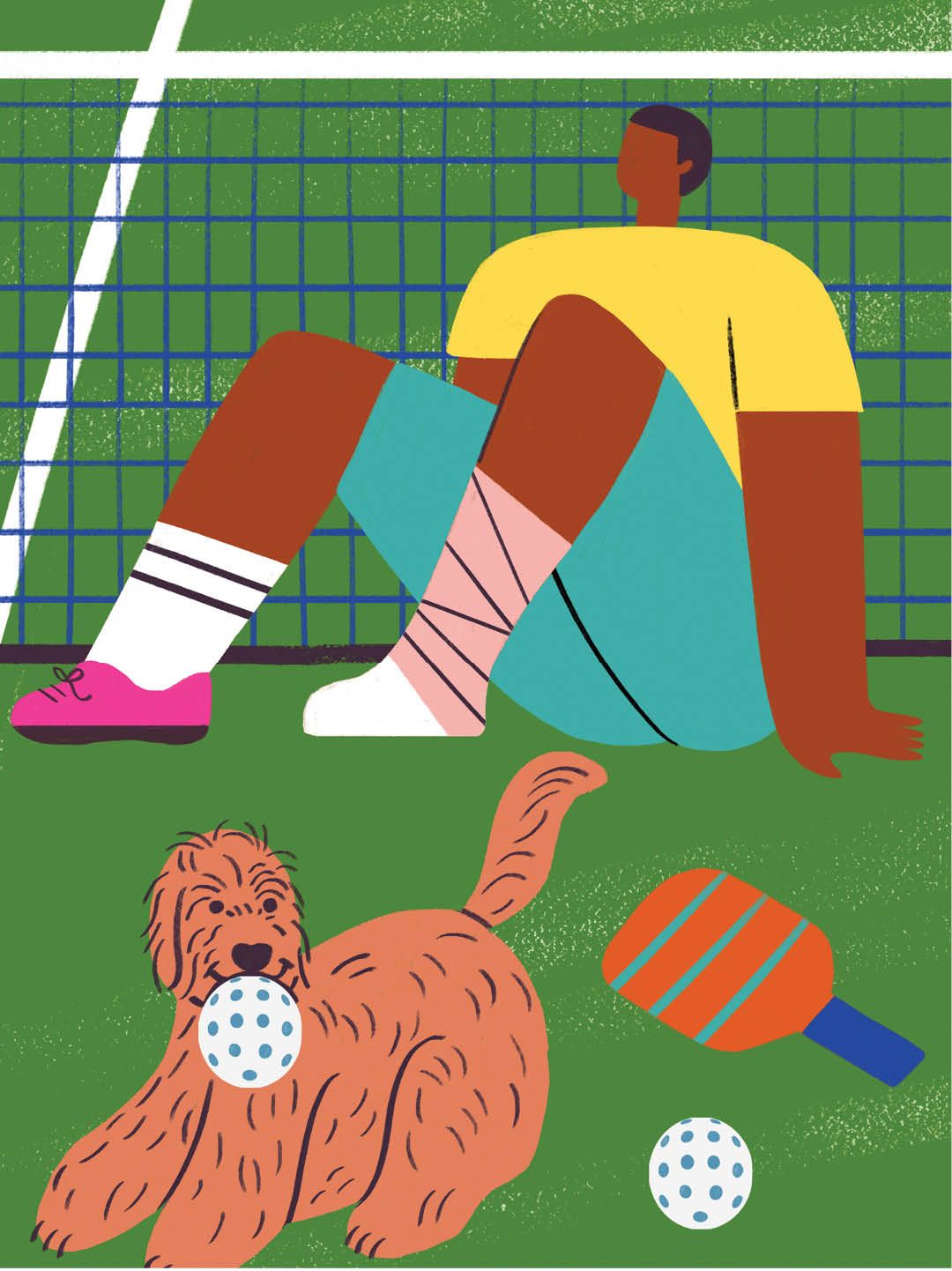
The consensus is that pickleball caught on because it is easy to learn, fast-paced, social, informal and fun. You don’t need fancy equipment (although some racquets can cost upward of $300, a decent one can be had for $29), balls can be used again and again, and dress is comfortable and casual. Also, it’s good for your health.
“Racquet sports are among the healthiest sports there are,” says Neeru Jayanthi, a sports medicine physician and associate professor of orthopedics. “Large studies show a 56 percent risk reduction in cardiovascular events, and people who play raquet sports live almost nine years longer, on average. It’s not only the physical benefits, but also the social.”
Jayanthi, who leads Emory’s tennis medicine program, played and competed in tennis for 40 years before ever picking up a pickleball paddle. Now, he thoroughly enjoys the sport.
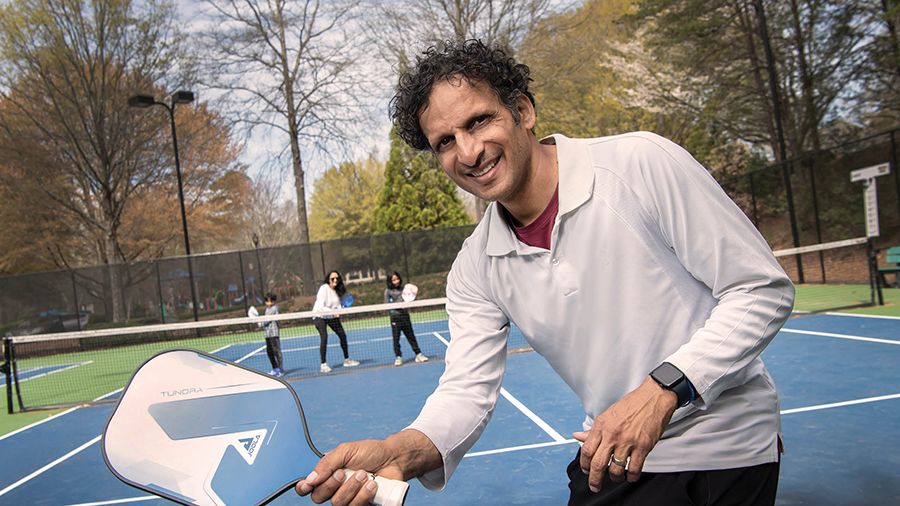
Sports medicine physician Neeru Jayanthi (above) and his family play pickleball on their neighborhood courts. “Racquet sports are among the healthiest sports there are,” he says.
Sports medicine physician Neeru Jayanthi (above) and his family play pickleball on their neighborhood courts. “Racquet sports are among the healthiest sports there are,” he says.
“My wife and I play with our neighborhood league, and we’re having a blast,” he says. “It’s a social outlet that involves an activity. There’s not as steep a learning curve as tennis, and the whole family can get involved. Tennis and pickleball can coexist.”
Indeed, while pickleball players have tended to come from an older demographic, that’s evolving as the sport’s popularity grows. In fact, players in the age group 18 to 34 now make up the largest percentage of pickleball players. “The landscape is changing,” Jayanthi says. “Pickleball is for younger athletic people too, and can be quite competitive. Students are playing it in high school, and there are college scholarships available.”

Play at Your Own Risk

Pickleball injury data show injuries tied to the sport among players 60 and older have been rapidly increasing for years, becoming an “important cause of injury” for seniors.
Lee Kneer, a sports medicine physician and assistant professor of orthopedics and physical medicine and rehabilitation at Emory, says he has played pickleball and understands its attraction. “It’s fun, fast, and social. But it can also lead to fairly catastrophic injuries,” says Kneer. “These are not three-day recovery kind of injuries. I am treating Achilles tendon ruptures, ankle fractures, knee ligament and meniscus tears, disc herniations in the back, clavicle (collarbone) fractures, wrist fractures.”
The most common pickleball injuries reported nationally are strains and sprains, then fractures and contusions. More specifically, sprained wrists and ankles, damage to the anterior cruciate ligament (ACL), rotator cuff injuries, meniscus tears, and Achilles tendon tears/strains.
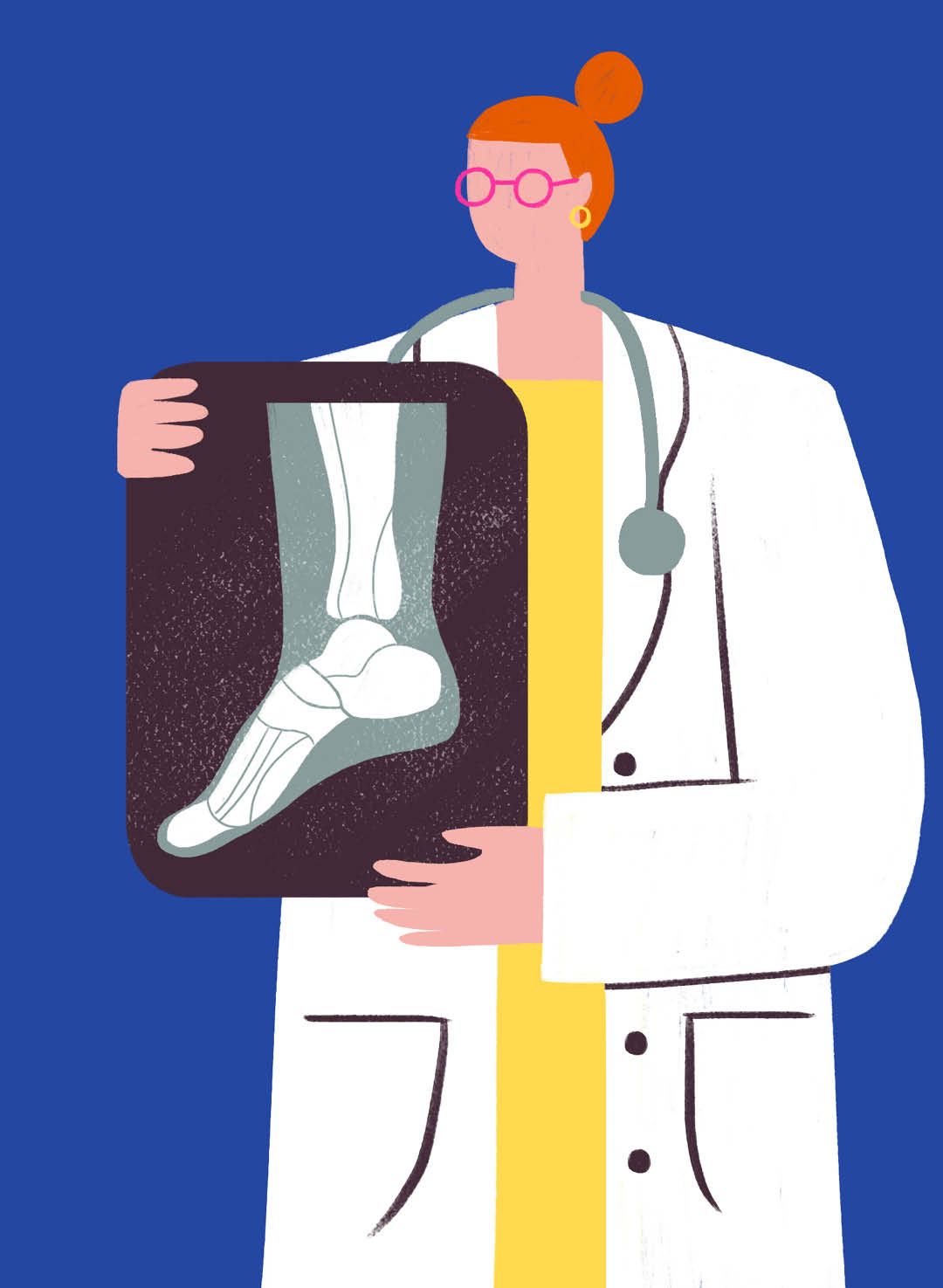
“There’s not a lot of pickleball injury distribution studies or rates yet,” says Jayanthi. “We did adult studies over one year for tennis players… and about half had some type of injury, pain, or mechanism that kept them from playing for 3 to 7 days. I would suspect adult pickleball players would have about the same injury rates.”
Body parts most frequently injured were wrists, lower legs/ankles, heads, and lower trunks. Other injuries involved the knees, shoulders, fingers, and faces (65-year-old Michelle Pfeiffer recently posted a photo of a black eye she received from the sport on her social media, warning “Stay out of the kitchen!”).
Senior males were more likely to suffer a pickleball-related strain or sprain, whereas senior women were more likely to suffer a fracture, especially of the wrist and hand. Bone fractures related to pickleball have increased dramatically over the past few decades, with most occurring in adults ages 60 to 69 during a fall, according to a recent study by the American Academy of Orthopaedic Surgeons.
Young players receive injuries as well. One injury you see more often among young competitive players? Eye injuries. Some professional picklers have taken to wearing safety goggles due to fast-paced play in the kitchen. Injuries occur with any sport, say the doctors, and racquet sports are no exception. “You do see a lot of the same injuries as in tennis, but for different reasons,” says Jayanthi. “The smaller court size and underarm serving in pickleball mean less impact on your legs and shoulders. But pickleball, by its nature, involves more elbow and wrist motion, and there’s rapid directional changes and a lot of forward and back movements in a short space. You’re taking quick, little steps, whereas bigger steps are more stable.”
Kneer says friendly pickleball games tend to be safer than highly competitive games with a lot of diving for balls and darting back and forth. “When playing a fast-twitch sport, you’re exposing yourself to more chance of injury,” he says, with those chances increasing as you get older. “The elasticity in your bodily structures decreases over time.”
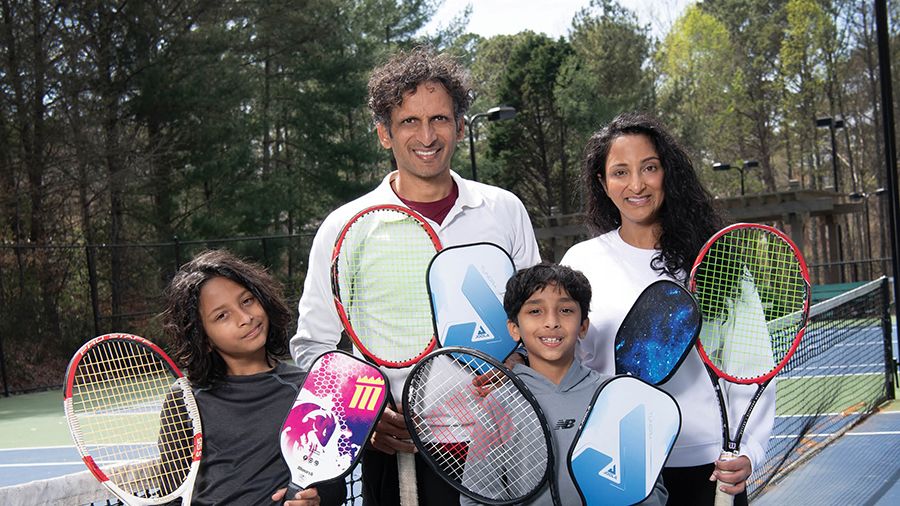
While still a tennis enthusiast, Jayanthi has added pickleball to his sports regimen. “Tennis and pickleball can coexist,” he says.
While still a tennis enthusiast, Jayanthi has added pickleball to his sports regimen. “Tennis and pickleball can coexist,” he says.

Pickleball Elbow

For an active GenXer who welcomed another way to stay physically fit, a pickleball injury was a surprising blow. “Our friends asked my husband and me to play on some city courts nearby,” says Jaye Watson, 54, co-executive producer and host of Your Fantastic Mind on PBS with Emory Brain Health. “We met at 9:00 a.m. and had a ball. I had been kind of judgmental about pickleball previously. It has a silly name and I thought it was an ‘old people’s’ sport. But that morning was the hardest I had laughed all year.”
Watson walked regularly—an hour every morning—as well as doing yoga, Pelaton, and weightlifting.
But pickleball added a social element she had missed. “As adults, we don’t really play games for fun anymore,” she says. “Pickleball was so fun we never even kept score. We played once a week for about a month.”
Then she and her husband discovered the YMCA had new pickleball courts. They played singles and got competitive with a lot of cross-court action. “We played three days in a row and at the end of the third day, I noticed my elbow hurt,” she says.
Her health saga has lasted nearly a year. Thinking it was a muscle strain, Watson iced and took Advil. But after a month, when the pain hadn’t subsided, she went to a sports medicine doctor who said it could be tennis elbow. “From playing pickleball seven times?” she asked. This was followed by three months of physical therapy and an MRI, which showed a partial tear of the extensor tendon.
“It’s been so humbling that I’m not invincible,” says Watson. “I’m still having pain in my elbow. I’m back to walking but, sadly, I don’t think I will ever play pickleball again.”

Jaye Watson, Emory Brain Health producer/host of Your Fantastic Mind, sustained a pickleball injury.
Jaye Watson, Emory Brain Health producer/host of Your Fantastic Mind, sustained a pickleball injury.
Risk Benefit Analysis

Kneer recommends focusing on foundational exercises that maintain or increase your body’s flexibility, strength, and stability, then “treating yourself with whatever gives your exercise life fulfillment. Pickleball shouldn’t be your primary or only form of exercise.”
Ultimately, Jayanthi believes the benefits of racquet sports counterbalance the risks. “The chance of an injury is always there for anyone engaged in physical activity, especially if someone is older and was not athletic previously,” he says. “But the social and health benefits, as well as living longer, clearly outweigh those additional risks.” EHD
By Mary Loftus, Illustrations by Josie Portill0

Lee Kneer, Emory sports medicine physician
Lee Kneer, Emory sports medicine physician
Reduce Your Chance of Injury
- Warm up before playing, by following a warm-up regimen developed by experts specifically for racquet sports (Download top ten list).
- Choose the correct shoe, with the proper construction to handle the lateral, side-to-side motions. Tennis shoes work but not old running shoes.
- Keep a wide stance while receiving during the game and avoid “backpedaling” to return an overhead shot.
- Learn to fall in a way that’s less likely to lead to injury. If you fall toward your side, going into a gentle roll, you can protect your head while not putting your wrists at risk.
- Pace yourself. If you play too often or maintain a high-intensity level, you will increase your injury risk. Start by playing once a week and assess how you feel after a few weeks. Then you can decide whether more or less pickleball makes sense for you.
- Return gradually. If you do get injured, return to play slowly. Test your limits and endurance.
- Improve flexibility and strength. Consider working out with a personal trainer or at a local gym to improve muscle strength, flexibility, and balance.
- Wear protective eyewear if you are so inclined or are playing at levels high enough for rapid back and
forth drives at the net. - Practice standing on one foot then the other, while brushing your teeth or in line at the grocery store, to improve balance.



